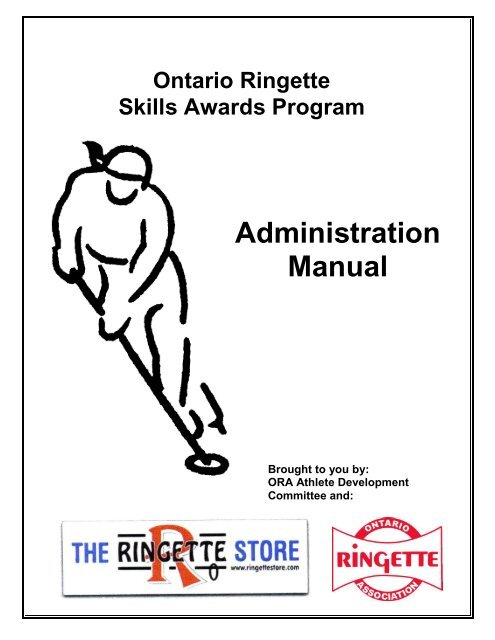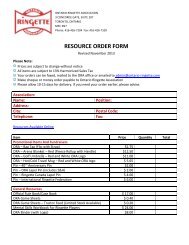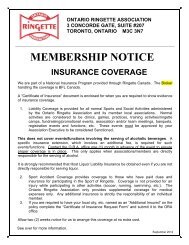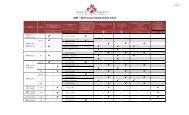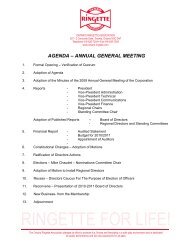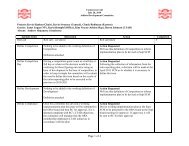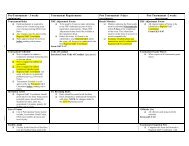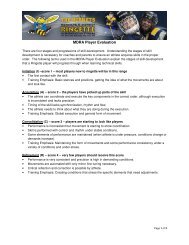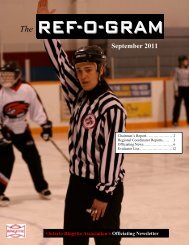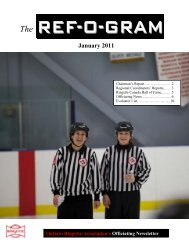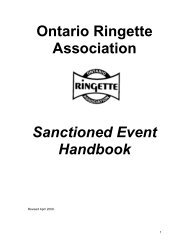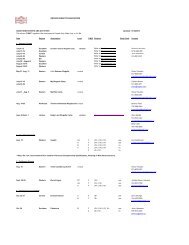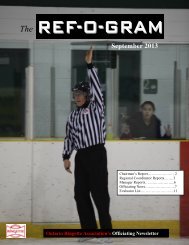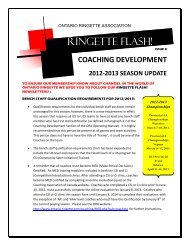Administration Manual - Ontario Ringette Association
Administration Manual - Ontario Ringette Association
Administration Manual - Ontario Ringette Association
Create successful ePaper yourself
Turn your PDF publications into a flip-book with our unique Google optimized e-Paper software.
<strong>Ontario</strong> <strong>Ringette</strong>Skills Awards Program<strong>Administration</strong><strong>Manual</strong>Brought to you by:ORA Athlete DevelopmentCommittee and:
GENERAL INSTRUCTIONSThere is a choice of two administration options which can be utilized when hosting the<strong>Ringette</strong> Store Skill Awards Program.A) CLINIC/CAMP OPTIONThe first option applies to a clinic or camp situation when a large number ofplayers are participating. This option requires a large amount of advancedplanning and organization with approximately 10-15 volunteers. This option isoutlined in detail under the "Test <strong>Administration</strong> " section of this manual.B) TEAM OPTIONThis option is used in the event of a smaller group and is usually less formal. Thecoach with parents would be able to administer this test for 15 to 20 players duringa practice hour.The <strong>Ringette</strong> Store Skills Awards Program is an excellent method to evaluateplayers' skills on an ongoing basis.TEST ADMINISTRATIONThe Host should ensure the following aspects of the event:One Month before Skills Testing Day1 - Contact the ORA office for the <strong>Administration</strong> manual for the Skills AwardProgram and place your order for the number of expected awards to be handed out.2 - review the requirements for the tests, and ensure that arrangements have beenmade for sufficient ice time, volunteers, equipment and publicity.3 - determined the required ice time by the total number of participants. Largegroups, such as more than 40, should be split into small sub groups and testedseparately, with each group needing an hour of ice.4 - obtain the following materials and equipment required to operate the programand ensure that they will be available at the test site:4 stop watches Certificate of Achievement (Optional)fifteen rings ( minimum) Performance report form20 pylons Goaltender summary -1 for each goalkeepershooting boardParticipant evaluation form ( optional)25 metre tape measure <strong>Administration</strong> evaluation formclipboards and pencilsextra player sticks
5 - Recruit sufficient volunteers:1 - One Head evaluator who is responsible for the one ice administration of theprogram on testing day. This involves everything from ensuring that the properequipment is available to making sure evaluators are in place to operate the eventeffectively.2 - One Evaluator on the ice for each test station (there are 5 ). Junior, Belle, Openplayers and parents - anyone who wants to join, could be asked to lend a hand3 - Two or 3 volunteers off the ice to co-ordinate players and handle registration4 - Two or 3 volunteers to compute scores, determine award levels, write ourcertificates, keep up with a master score sheet and co-ordinate the presentation ofawards.6 - Invite Dignitaries - local sponsor if nearby, local Athlete Development Rep,President of local <strong>Association</strong>, League or Region, are a few examples.On Testing Day1. Ensure that all stations are marked correctly as per the test requirements.NOTE: They must be exactly as indicated in this manual.2. Designate appropriate dressing rooms and post signs in the lobby.3. Post large clear signs indicating registration station, and award station.4. Record each player's name and age on working copies of scores heets before theplayers go on the ice. The Masters of the score sheets for the players andgoaltenders are included.5. The Head Evaluator should complete most of the certificates in advance ifcertificates are to be handed out.6. Ensure that everyone is briefed in all aspects of the testing so that questions maybe answered by anyone involved. Demonstrations and group discussions arehelpful prior to the event.7. Provide pencils for recording.8. Before going through the test, the test should be described or demonstrated forthe participants.9. Divide the participants into 5 equal groups. Assign a starting station to eachgroup.10. Do not skip over warm ups. The payers need this, both office and on ice.
During Testing1. Each Evaluator should have the Skills Award Summary sheet when at theirassigned station.2. The Evaluator should describe the test at that station, the same way to eachgroup as they arrive and does all the time for that test. The Evaluator recordsthe marks for each player as they go through the drill.3. Each group rotates through all the stations usually in a counter-clockwisedirection.4. Spectators and waiting players should stay clear so as not to distract theparticipants. This program should be able to be completed in one hour.5. Time for the events must be recorded to at least one decimal point to makescoring accurate. For example: 4.2 or 4.23 but not 4.6. Each player is to be given two trials of each test and the best trial will beconsidered in scoring of the test. The player's best time for each test should becircled by the evaluator as the tests are completed.7. There are no penalties for false starts or improper performance of the testssuch as turning the wrong way. The trails in question are simply not used.After Testing1. Collect all performance reports from the participants, if you have arrangedfor the participants to each carry their own report.2. Based on the schedule of NORMS, the player' age and the test scores, computethe final result (Gold, Silver or Bronze.) for each participant. For example - addup the best times from the four timed events and subtract the shooting/throwing bonus).3. Complete the participant's certificates, if you are handing out certificates.4. Have the participants head over to the awards area5. Present awards to each player - remember to emphasize that the players weregoing against a Standard and not against each other for these awards. Eachplayer should receive a Ribbon from the <strong>Ringette</strong> Store.6. Transfer all times and the overall scores to the Summary sheets. And havesomeone assigned to keep these as Records for when you run this programagain.Another Option in Conducting the Skills Awards ProgramYou may wish to consider that all players receive the Bronze level ribbon on theirfirst attempt with this Skills Award program, and then must achieve higher levels insubsequent testing in order to receive the Silver award and then achieve even higherlevels for the Gold award. This allows players to continue to strive for greaterachievements should they surpass the NORM level early.
Test Number 1 - Forward Speed Skating Test (All players)Purpose: To measure the forward skating speed of a player.Equipment/Set-up (FIG. 2)• one stopwatch is required.• mark a line 24.4 m (80 feet) from the goal line.• 2 cones are placed at both the starting and finish lines.ExecutionStart the player behind the start line. Time begins when the player touches the start line. Theplayer skates forward as fast as he/she can to the finish line where timing stops when bothskates have crossed the line.Test Number 2 - Backward Speed Skating Test (All players):Purpose: To measure the backward skating speed of a player.Equipment/Set-up (FIG. 3)• one stopwatch is required• mark a line 15.86 m (52 feet) from the goal line.• 2 cones are placed at both the starting and finish lines.Execution:Start the player behind the goal line. The time begins when the player's skates touch the line. Theplayer skates backwards to the finish line, and timing ends when both skates have touched thefinish line.
Test Number 3A - Agility Test (players only):Purpose:To measure the player's agility and basic skills of the front start, acceleration,stopping and stabbing of a stationary ring.Equipment/Set-Up (FIG. 4)* one stopwatch is required* one pylon 1 m (3 feet) behind the goal line* 2 rings placed on two points 9.15 m (30 feet) from the goal line.Execution:The player starts by lying in a face-down position, with his/her forehead on the goal line. On thesignal, the player gets up, skates to the rings, stabs one and places it behind the furthest pylon(he/she must place it behind the pylon). He/she then returns for the second ring and places itbehind the same pylon. Timing begins on the signal, and ends when both skates touch the goalline while he/she is carrying the second ring."HINT":Advise the participants that stopping and changing direction while picking up thering is quicker than using a sharp turn.
Test Number 36 - Combo Drill (Goalkeeper)Purpose: To measure a Goalkeeper's Agility.Equipment/set-up (FIG. 5)Execution:A goalie net and crease are required for this drillOne stopwatch is requiredThe goalkeeper starts the drill hugging the left post. Using shuffle steps, move along the bluecrease line to the right and hug the right post. Then shuffle along the crease, back to the startingposition. Then execute a T-push or one shuffle step straight across to the right post. Continue bytelescoping forward to the centre of the right free pass circle and retreating to the right post. T-push straight across to the left post. Finish by telescoping to the centre of the left free passcircle and retreating to the left post.FIG. 5
Test Number 4 - Ringhandlinq (All Players)Purpose:To measure the player's ability to handle the ring while skating through an obstaclecourse.Equipment/Set-up (FIG. 6)• one stopwatch is required• one ring (placed beside pylon 1)• pylon #1 is placed 4.88 m (16 feet) from the starting line (the goal line) and pylons #2, #3,#4 and #5 are placed in a straight line perpendicular to the starting line with a distance of1.83 m (6 feet) between consecutive pylons.• pylon #6 and #7 are placed (respectively) 1.83 m (6 feet) from pylons #4 and #2.Execution:The player starts behind the goal line. The time starts when the player's skate touches thestarting line. Skating towards the pylons, a ring is picked up beside, to the right of pylon #1. Theplayer skates to the left of pylon #2, to the right of pylon #3 and so on in a swerving fashion. Thering must also go around the pylons. At pylon #5 the player makes a sharp turn, and skates topylon #6. The player makes complete circles around pylons #6 and #7 (in opposite directions).The time stops when the player crosses the finish line with the ring."HINT": Advise the participants that although this is a timed test, it is important to have bothbody and ring in control as you go around comers.1.83mSTART/FINISHLINEFIG. 6
Test Number 5A - Shooting Test (Players)Purpose: To measure the player's shooting accuracy.Equipment/Set-up (FIG. 7)• one net• one shooting board• 5 rings 6.1 m (20 feet) from goal lineExecution:The player takes five shots at the shooting board. The player may take any type of shot on thenet. Stationary and moving shots are permissible. The players stick must not cross the (6.1 m)line while in contact with the ring.Players receive a bonus for the number of targets hit. This bonus is time which is taken off thetotal of the (four) timed skills. A bonus is given as follows:0.5 second for a bottom target1.0 second for a top targetThe maximum bonus is 3.0 seconds
Test Number SB - Ring Throw(Goalkeeper)Purpose: To measure the ring throwing accuracy of a goalkeeper.Equipment/Set-up (FIG. 8)• Four (4) pylons• 5 ringsExecution:1. Pairs of pylons are positioned at the top of each free pass circle on the free play line. Thereshould be a distance of 1.53m (5 feet) between each pair of pylons.2. Five rings are placed inside the goal crease.3. The goalkeeper picks up and attempts to throw a ring (between one set of pylons).4. This is repeated for all five rings alternating from left to right.5. The goalkeeper is given a bonus (to a maximum of 3) for each ring thrown between one set ofpylons. Each bonus is worth one second. This time is taken off the total of the (four) timedskills.
The <strong>Ringette</strong> StoreSkills AwardsProgramThis is to certify that…Has successfully completed allof the <strong>Ringette</strong> skill tests this dayof ________ the year of ______.We recognize this athlete’sdemonstrated skill in the sport of<strong>Ringette</strong>.


